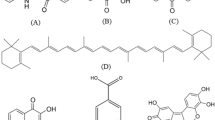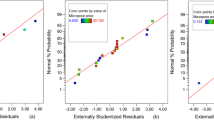Abstract
It was found that three kinds of the synthetic food additive dyes, red nr. 3 (erythrosine), nr. 104 (phloxine), and nr. 105 (rose bengal) were adsorbed to the surface of charred cellulose granules and the maximum amounts of adsorption of these dyes were 3.75, 3.42, and 4.74 mg/g cellulose, respectively. Scanning electron microscopy-electron probe micro analysis (SEM-EPMA) showed a coating of the dyes on the surface of charred cellulose granules. Electron spectroscopy for chemical analysis (ESCA) suggested the presence of NH3 + in the surface of charred cellulose granules. Since all three dye compounds have both anionic carboxylate and hydrophobic groups and were released from the surface of charred cellulose granules by 0.1 N NaOH solution, it was surmised that these three food additive dyes were bound to the surface of cellulose granules by both ionic and physical interactions.








Similar content being viewed by others

References
AACC International (1995) Approved methods of the AACC international, 9th edn. Method 46-10, approved April 1961, revised October 1981 and October 1986 final approval November 1995. AACC International, St. Paul, MN
Augustine GJ Jr, Levitan H (1980) Neurotransmitter release from a vertebrate neuromuscular synapse affected by a food dye. Science 207:1489–1490
Bansal RC, Goyal M (2005) Activated carbon adsorption. CRC Press Taylor & Francis Group, Boca Raton, FL
Borzelleca JF, Capen CC, Hallagan JB (1987) Life time toxicity/carcinogenicity study of FD & C Red nr. 3 (erythrosine) in rats. Food Chem Toxicol 25:723–733
Egoshi K, Nakaoka H, Oka T, Abo K (1997) Adsorption of heterocyclic aromatic amines by low molecular weight cellulose. J Food Hyg Soc Japan 38:435–440
Ferguson LR, Roberton AM, Watson ME, Kestell P, Harris PJ (1993) The adsorption of a range of dietary carcinogens by α-cellulose, a model insoluble dietary fiber. Mutation Res 319:257–266
Gupta VK, Mittal A, Kurup L, Mittal J (2006) Adsorption of hazardous dye, erythrosine, over hen feathers. J Colloid Interface Sci 304:52–57
Inglesby MK, Zeronian SH (2002) Direct dyes as molecular sensors to characterize cellulose substrates. Cellulose 9:19–29
Jones JM (2007) Dietary fibre components and functions. Wageningen Academic Publishers, The Netherlands, pp 13–30
Kamata E (1995) Spherical nucleus, spherical granule and their production. Japan patent 7-173050
Koberstein VE, Lakatos E, Voll M (1971) Zur charakterisierung der oberflachen von ruben und hochdispersen kieselsauren. Berichte der Bunsen-Gesellschaft 75:1104–1114
Kuno N, Mizutani T (2005) Influence of synthetic and natural food dyes on activities of CYP2A6, UGT1A6, and UGT2B7. J Toxicol Environ Health 68:1431–1444
Kuroda Y (1975) Mutagenesis in cultured human diploid cells. IV. Induction of 8-azaguanine resistant mutations by phloxine, a mutagenic red dye. Mutat Res 30:239–248
Lenard J, Vandeloef R (1993) Photoinactivation of influenza virus fusion and infectivity by rose bengal. Photochem Photobiol 58:527–531
Levitt M, Perutz MF (1988) Aromatic rings act as hydrogen bond acceptors. J Mol Biol 201:751–754
Pereira L, Ali B, Mohite K, Arona P, Rao CV (2000) A study of mutagenic effects of spurious lipsticks chemicals in Drosophila melanogaster. J Environ Biol 21:309–315
Sasaki YF, Kawaguchi S, Kamaya A, Ohshita M, Kabasaki K, Iwama K, Taniguchi K, Tsuda S (2002) The comet assay with 8 mouse organs: results with 39 currently used food additives. Mutat Res 519:103–119
Seguchi M (1984a) Oil-binding capacity of prime starch from chlorinated wheat flour. Cereal Chem 61:241–244
Seguchi M (1984b) Comparison of oil-binding ability of different chlorinated starches. Cereal Chem 61:244–247
Seguchi M (1984c) Oil-binding ability of heat-treated wheat starch. Cereal Chem 61:248–250
Seguchi M (1985) Model experiments on hydrophobicity of chlorinated starch and hydrophobicity of chlorinated surface protein. Cereal Chem 62:166–169
Seguchi M (1987) Effect of chlorination on the hydrophobicity of wheat starch. Cereal Chem 64:281–282
Seguchi M (1990) Study of wheat starch surface proteins from chlorinated wheat flours. Cereal Chem 67:258–260
Seguchi M (1993) Contribution of wheat starch granule hydrophobicity to pancake texture. Cereal Foods World 38:493–497
Seguchi M, Matsuki J (1977) Studies on pan-cake baking. I. Effect of chlorination of flour on pan-cake qualities. Cereal Chem 54:287–299
Seguchi M, Tabara A, Fukawa I, Ono H, Kumashiro C, Yoshino Y, Kusunose C, Yamane C (2007) Effects of size of cellulose granules on dough rheology, microscopy, and breadmaking properties. J Food Sci 72:79–84
Takeuchi M, Hara M, Inoue T, Kada T (1988) Adsorption of mutagens by refined corn bran. Mutat Res 204:263–267
Tanaka T (2001) Reproductive and neurobehavioural toxicity study of erythrosine administered to mice in the diet. Food Chem Toxicol 39:447–454
Tomlinson G, Cummings MD, Hryshko L (1986) Photoinactivation of acetylcholineesterase by erythrosine B and related compounds. Biochem Cell Biol 64:515–522
Tsuda S, Murakami M, Matsusaka N, Kano K, Taniguchi K, Sasaki YF (2001) DNA damage induced by red food dyes orally administered to pregnant and male mice. Toxicol Sci 61:92–99
Uesugi N, Furumiya K, Mizutani T (2006) Inhibition mechanism of UDP-glucuronosyltransferase 1A6 by xanthene food dyes. J Health Sci 52:549–557
Uysal OK, Aral EC (1998) Teratogenic effects and the role in the etiology of atopic disesases of erythrosine (FD & C Red nr. 3). Tur J Med Sci 28:363–368
Wang H, Lu L, Zhu S, Li Y, Cai W (2006) The phototoxicity of Xanthene derivatives against Escherichia coli, Staphylococcus aureus, and Saccaromyces cerevisiae. Curr Microbiol 52:1–5
Yokota S, Ohta T, Kitaoka T, Ona T, Wariishi H (2009) Preparation and characteristics of anionic polyacrylamides containing direct dye with a high affinity for cellulose. BioResources 4:497–508
Author information
Authors and Affiliations
Corresponding author
Rights and permissions
About this article
Cite this article
Tabara, A., Yamane, C., Abe, M. et al. Adsorption of xanthene food additive dyes to cellulose granules. Cellulose 18, 45–55 (2011). https://doi.org/10.1007/s10570-010-9462-2
Received:
Accepted:
Published:
Issue Date:
DOI: https://doi.org/10.1007/s10570-010-9462-2



